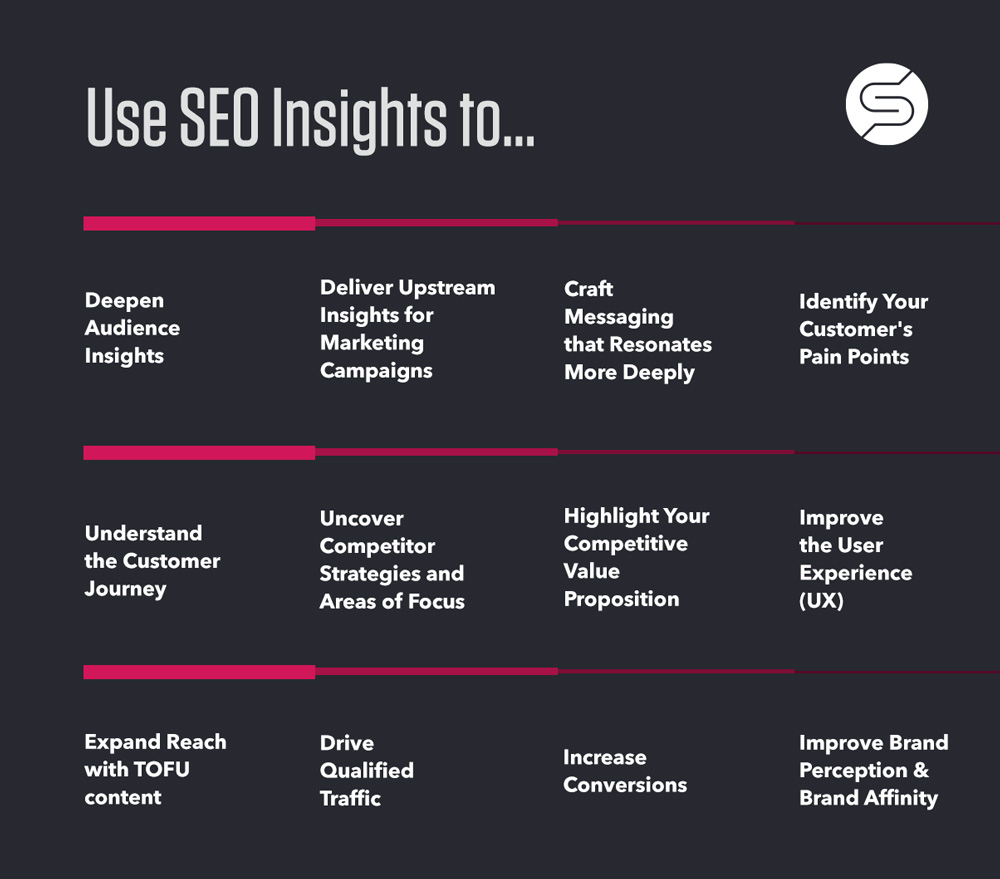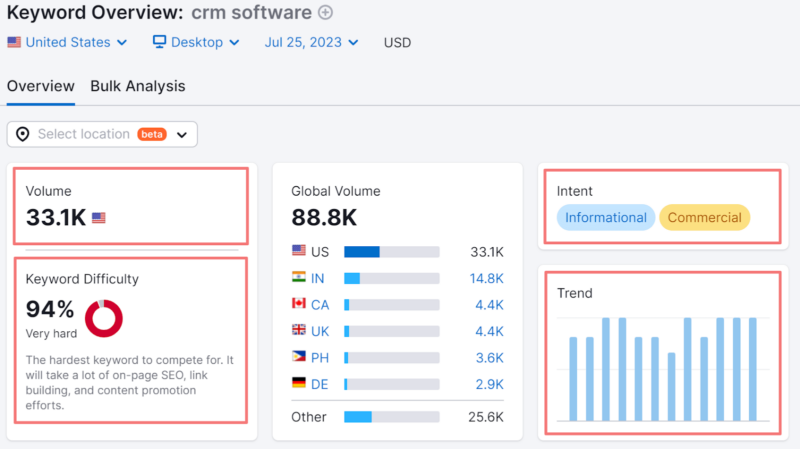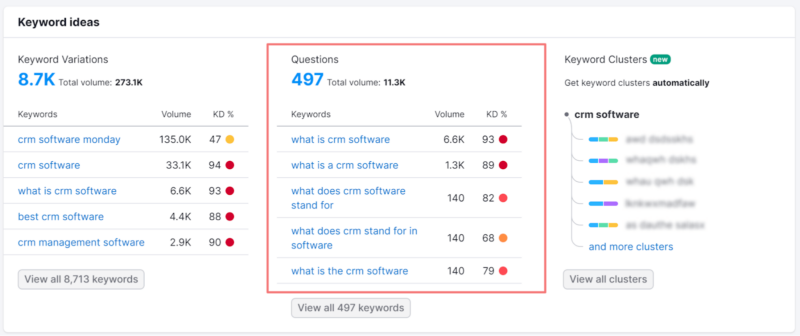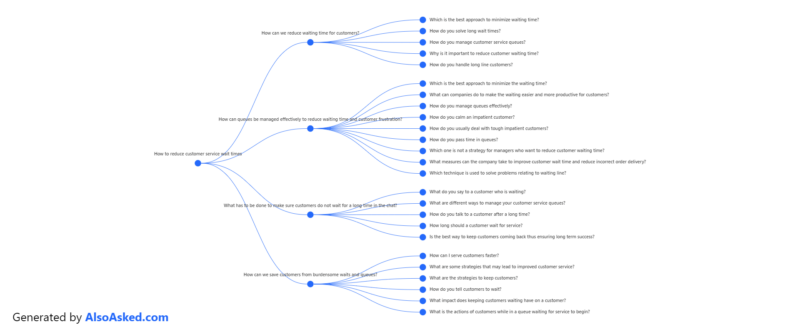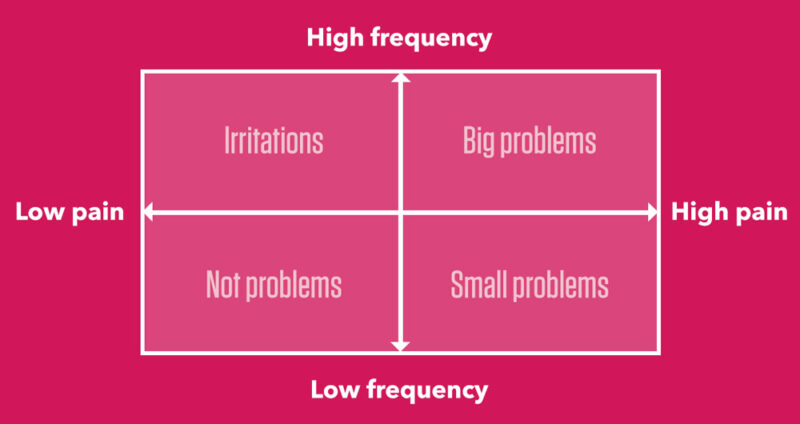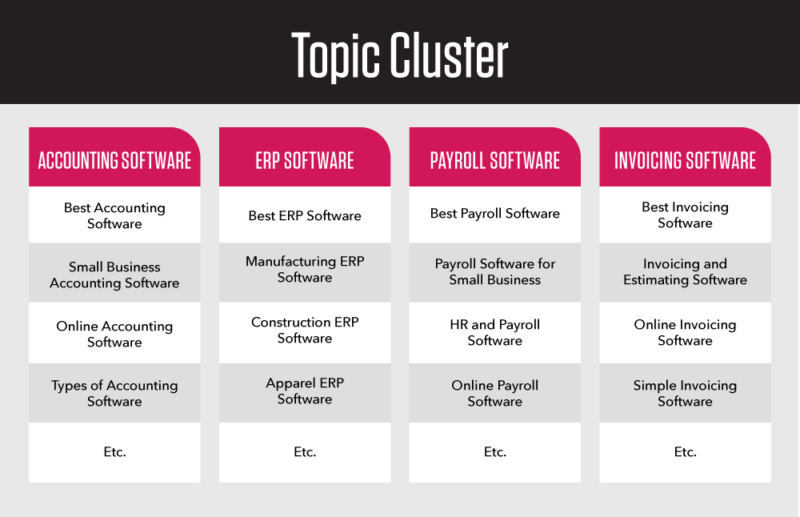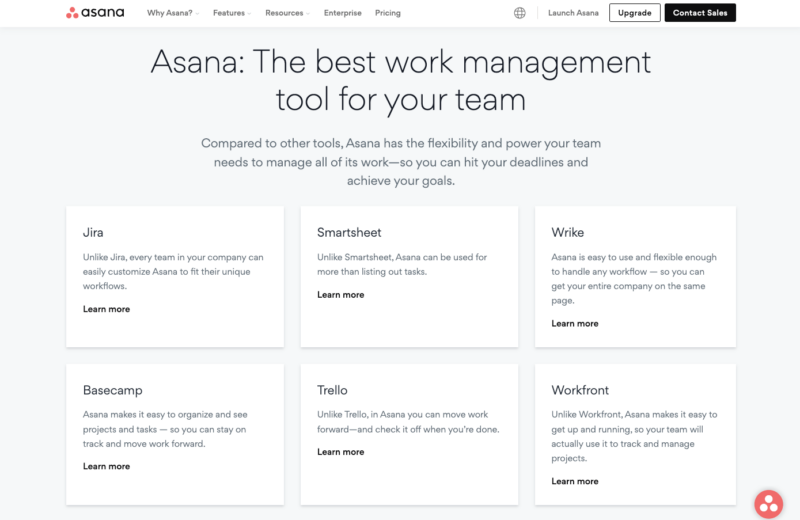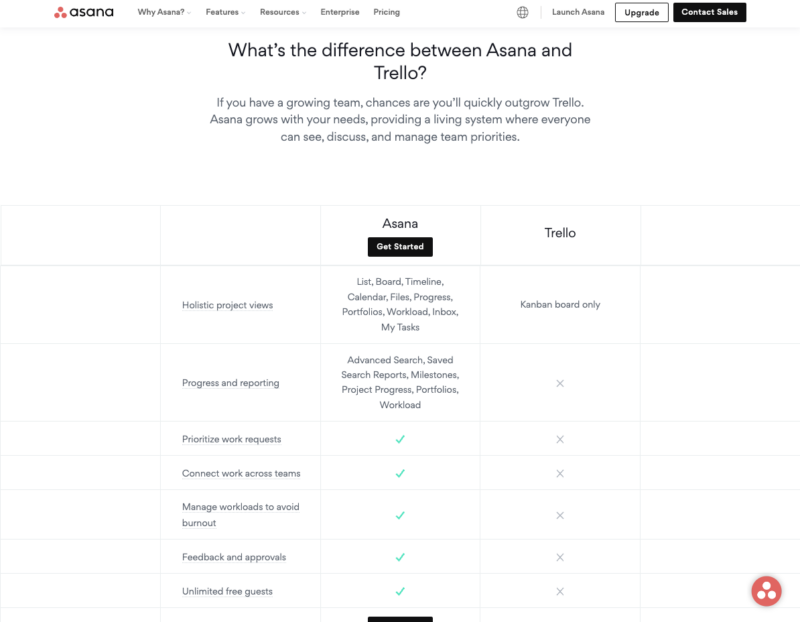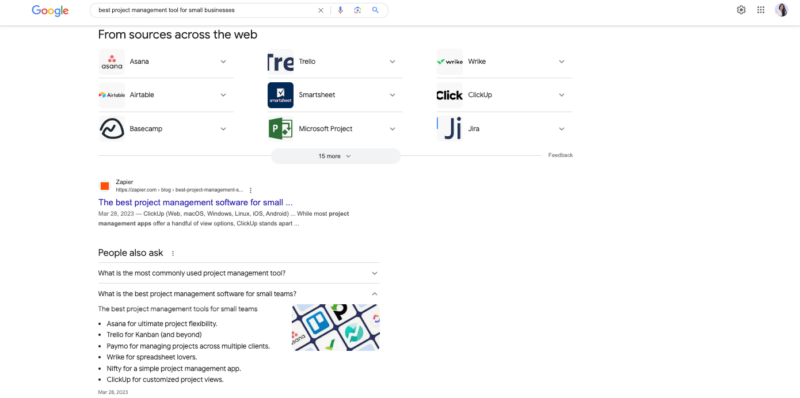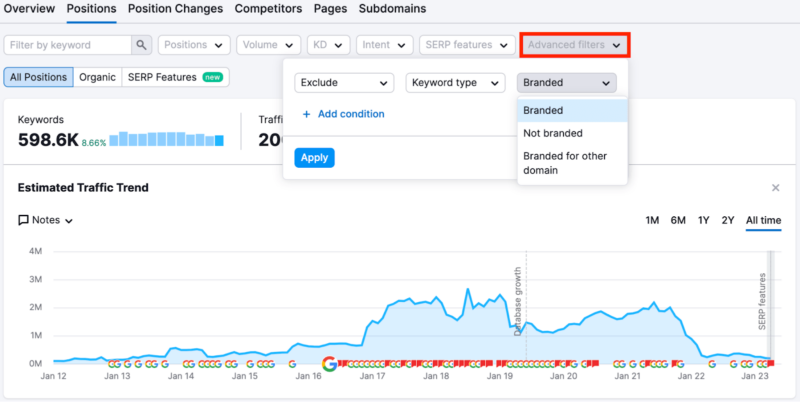How to Use SEO Insights to Strengthen Your Marketing Strategy

Is SEO useful for achieving Google rankings? Of course.
How about organic traffic? Yep!
But why is it that many marketers shortsightedly stop there in their thinking?
What they fail to realize is that, when done right, rankings and traffic are merely a fraction of the value that organic search represents for your business overall. What they don’t realize is all the untapped opportunities they are leaving on the table and consequently all the ways they are limiting business growth.
SEO insights help you to strengthen your marketing strategy, initiatives, and results across the board:
Let’s set the record straight and start using B2B SEO data far more strategically. Read on and uncover different ways that you can capitalize on SEO insights for transformational impact on your business.
What Many Marketers Get Wrong about SEO
Types of SEO Data for Deeper Insights
12 Ways to Use SEO Insights For Your Marketing Strategy
By incorporating SEO data into our overall marketing, we B2B companies can enhance content creation, refine competitive positioning, and optimize user experience to drive better overall marketing performance and generate quality leads. For example, SEO data enables us to more precisely target our audience while concurrently identifying key gaps with competitors.
Here’s how SEO data can help you with your marketing strategy:
1. Deepen Audience Insights
SEO data offers a rare, unfiltered look into your audience’s mind. The keywords they use, the phrases they search for, the questions they ask—all these provide invaluable insights into their needs, preferences, and pain points.
Tools like thruuu, AlsoAsked, and Answer Socrates act as magnifying glasses and give you a closer look at these nuggets of information.
They provide insights from People Also Ask (PAA) questions from the Google search engine results pages (SERPs), uncover related search queries via Google autocomplete, and identify search trends using Google Trends. These tools allow you to delve deeper into your audience’s concerns and interests.
For example, here are questions being asked online related to “How to reduce customer service wait times” on AlsoAsked.
This information shows that your target audience needs solutions to this problem.
When you have these insights, develop content plans and calendars that will resonate deeply with your audience.
While SEO data alone is not enough to build your buyer persona, it can make your strategy more customer-centric. For example, keyword research reveals the topics and questions that matter to your audience. And, analyzing organic traffic (yours and your competitors’) helps you understand which content resonates the most.
2. Use Upstream Insights for Marketing Campaigns
Upstream insights involve using your SEO data to shape or inform your upcoming marketing campaigns. It’s the opposite of retrofitting SEO, or optimizing what a marketing team has already developed.
Instead, your SEO insights is what determines the campaigns to conduct, based on your audience’s interests.
SEO insights also allow you to pivot your marketing strategies and product offerings to meet emerging customer needs and market trends. No better company made use of upstream insights than Zoom during COVID-19. The societal shift towards remote work drastically increased the need for reliable video communication tools.
Zoom tailored its marketing campaigns to highlight its product’s utility for remote teams, like superior video quality, easy scheduling, and integration with other tools.
Useful tools to uncover search trends include Google Trends, Exploding Topics, and Semrush.
When you combine your SEO insights with other audience research, such as from market research, surveys, customer interviews, and social listening, you’re able to craft powerful marketing campaigns with high impact and SEO ROI.
3. Craft Messaging that Resonates More Deeply
By understanding the specific words, phrases, and questions your audience is thinking about, you can craft messaging that aligns with the way they think. When you know the specific way that they articulate their problems, challenges, or frustrations, it’s easier to come up with messaging that’s right on the money.
According to Semrush, “crm software” has more than twice as many monthly Google searches in the U.S. than “crm system.” Comparatively, “crm tool” has less than half as many searches as “crm system.” And “crm platform” has fewer searches than “crm tool”, while “crm solution” has even fewer.
So, if you sell CRM software, you obviously want to lean into “crm software” in your messaging. Yet, I can point to a handful of CRM developers that speak to platform and solution instead.
Monthly CRM searches associated with “what is…” included in the query total more than 29,000. That’s a lot of people simply trying to figure out what the heck CRM stands for, what it does, and how it works. This indicates that simpler, explanatory language may resonate with a large percentage of newer audience members.
You can also see that there’s a healthy amount of searching for CRM software for specific business types or industries, such as small business, real estate, senior living, architectural firms, financial advisors, nonprofits, mortgages, and more. Given this, any CRM software provider would be wise to develop segmented marketing for their target verticals.
4. Identify Pain Points
Along the same lines, we can dive deeper into search data to explore and discover audience pain points to make your messaging even more powerful. Pain points are your ticket to creating strong hooks in your marketing that boost conversion rates.
If we continue our exploration into CRM software, we find that there are more than 4,600 monthly U.S. Google searches related to CRM that include the word “easy”. There are another 7,100+ that include the word “simple”. Clearly, a pain point of many of those looking for CRM software are eager for something that’s easy and not too difficult to implement.
Once you’ve identified their pain points, dig deeper to distinguish the important pain points with significant ramifications vs. those pain points that may be less serious or frequent. The Pain vs. Frequency Matrix identifies and prioritizes customer pain points based on their severity (pain) and how often they occur (frequency). This matrix provides insights to develop solutions that meet the most pressing and frequent customer needs.
5. Understand the Customer Journey
A B2B customer journey outlines the steps your customers go through when searching for a solution to a problem or to achieve a goal. This includes the realization that there’s an issue or opportunity. From there, the individual may go through many different iterations of searches online, engaging and interacting with various potential solution providers along the way.
The journey may include awareness, engagement, consideration, and decision making.
B2B SEO insights allow you to track the keywords and search queries your audience uses at different stages of their buying journey, which provides a clearer understanding of their needs, interests, and decision-making process at each distinct phase.
The SEO outcome from a B2B effort is often the insight, not the conversion. For example, look out for specific pages that result in contact form buttons being clicked or search queries that indicate buyer intent – these should be insights that should be expanded upon in not just SEO but other marketing channels too. Too often CMOs deprioritize B2B SEO campaigns that don’t “convert” [in a free trial, sales call, transaction, etc.] because they miss that conversion often isn’t the goal, it’s the top-of-funnel awareness and insights that lead the buyer down the funnel to another channel.
Let’s take Buffer as an example. The company targets top-of-the-funnel keywords with educational blog posts, free online tools, resources, a podcast, content library, and a social media glossary that introduce concepts related to social media marketing during the awareness stage.
This enables Buffer to expand reach among new audiences while subtly positioning the brand as a thought leader in the space.
As potential customers move into the consideration stage and begin comparing different platforms, Buffer creates content that helps its target audience understand what the tool does.
In the decision stage, when companies are ready to purchase, Buffer provides direct comparisons with competitors such as HootSuite. Customer testimonials, case studies, and reviews all help to cement the case for a Buffer purchase.
In this way, Buffer delivers content that’s the right fit for each stage of the customer journey.
6. Uncover Competitor Strategies and Areas of Focus
SEO data also tells you what your competitors are doing. Think of it as a little espionage but in the digital world.
Their top-performing content, backlinks, and most-targeted keywords tell you what areas they are focusing on and what direction they’re heading in.
There are multiple competitor data points you can examine. Here are a few you can start with:
- Keyword rankings: Understand which keywords your competitors are targeting and ranking for. These rankings help you identify keyword gaps that you can fill in on your site.
- Content topics: Review the topics your competitors cover in their content. These topics show clusters you might’ve missed out on and highlight issues and questions important to your target audience.
- Link profiles: Analyze where your competitors are getting their backlinks from. Determine whether you can reach out to these sources too.
- Website architecture: Look at the structure and layout of your competitors’ websites. How are their sites organized? How easy is it to navigate and find information? These insights can help you improve your website’s user experience and SEO.
- Traffic sources: Check the source of your competitors’ website traffic. Are they getting most of their visitors from organic search, social media, referral links, or paid advertising? Understanding these sources can show relevant channels for your audience and target the same.
7. Highlight Your Competitive Value Proposition
A competitive value proposition sets your product, service, or solution apart from the competition. It’s the unique mix of features and benefits that makes your offering stand out, shining a light on where you’re strong while competitors are weak.
SEO insights reveal what your target audience is yearning for, their pain points, preferences, and the specific language they use. This helps you to align and communicate your differentiation.
SEO insights helps you to identify these gaps. Analyze the keywords where your competitors rank well and investigate their offering.
Asana, for example, dedicates an entire section on its website to its comparisons with competitor tools.
An in-depth look at the Trello tab, for example, gives you content on how Asana delivers more value. A comparison chart highlights the gaps Asana fills that Trello doesn’t.
Can you identify any unfulfilled customer needs or weaknesses in their product? These could represent opportunities to differentiate your brand and strengthen your competitive value proposition.
8. Improve the User Experience (UX)
SEO and UX are like two peas in a pod. As much as it’s about targeting the right keywords, SEO is also about aligning with search intent and ensuring that users have a smooth and enjoyable experience when they visit your website.
88% of customers are less likely to return to a site after a poor user experience. Strong UX can lead to longer site visits, lower bounce rates, and higher conversion rates— factors that all positively impact your website performance.
By making your website SEO-friendly, what you’re essentially doing is making it more user-friendly in the process.
For example, be careful to align your content with search intent. Ensure the content is useful and comprehensive. And add internal links to guide your site visitors to valuable, related content that enhances their journey.
If a search term is a top-of-the-funnel (TOFU) keyword, be informative and educational. If a search term is a middle-of-the-funnel (MOFU) keyword, include useful information about your solutions along with links to webinars, use cases, and case studies.
In addition, SEO insights help you to structure your website in a way that aligns with the way your audience thinks about their challenges and your types of solutions. Use SEO insights to guide the actual information architecture (IA) of your site.
In this way, SEO helps you to build a great user experience.
9. Expand Reach with TOFU content
TOFU content is the initial stage of the customer journey, where they’re just becoming aware of a problem or need. At this stage, the goal is to reach as many potential customers as possible and engage them with informative, helpful content.
SEO is one of the most effective ways to reach TOFU audience members, precisely at the time that they are eager for your information and guidance.
To grow your business, it’s critically important to continually expand reach and capture new prospective customers. Ideally, you should have an engine in place to automate the filling of the funnel. To that end, SEO is extremely effective.
You create such content with TOFU SEO keywords—broad, often high-volume search terms that people use when they’re at the beginning of their information or purchasing journey. These keywords are generally within the broader context of your offering.
The more you can align and start engaging with your audience before they are even aware of your company or solutions, the greater likelihood that you’ll be able to nurture them effectively (through multiple channels) and keep them in your funnel as they progress through their journey towards a purchase.
10. Drive Qualified Traffic
Driving qualified traffic to your website means attracting visitors most likely to convert because they have a real interest in your product or service. This is one of the core benefits of SEO.
It’s not just about getting more eyeballs on your site—it’s about getting the right eyeballs with specific, relevant keywords and creating high-quality content around these terms. SEO sheds light on this data.
For example, a keyword phrase like “best project management tool for small businesses” suggests that the searcher is comparing options and nearing a decision. Optimizing your website and content for such ‘high-intent’ keywords as Zapier has draws in traffic more likely to convert.
SEO can also help you find long-tail keywords—longer, more specific keyword phrases that visitors are likely to use when they’re closer to the point of purchase. While these may have lower search volumes, they often have higher conversion rates as they’re more specific in nature.
For example, “cloud-based project management tool with built-in time tracking” reveals a very specific requirement and signifies a user that’s close to making a decision.
11. Increase Conversions
Conversions take many forms. Your site visitors may sign up for a webinar or download a playbook. They may click-through to view a case study, schedule a demo, or request to talk with your sales team.
On any given page, it may be difficult to know which type of conversion your site visitors are interested in. With SEO insights, though, you can align your CTAs with search intent to generate higher click-through rates. In this way, leverage your SEO insights to handcraft your CTAs per page.
If someone lands on your site from a “What is…” query in Google, your CTAs should be to click-through to additional blog posts or whitepapers. If someone instead came to your site looking for ABC pricing or ABC vs. Other Product, your CTAs can be more focused on closing the sale.
With higher conversions come more leads and sales. Use SEO insights to help you fuel your revenue growth.
12. Improve Brand Perception and Brand Affinity
Brand perception is all about how people see your brand. Brand affinity, on the other hand, is about how much your customers like you and feel a connection to your brand. In short, it’s about making your brand a customer’s favorite.
SEO insights can help you with both of these. Look at how often people search for your brand compared to your competitors to get an idea of your brand’s popularity.
For example, if searches for your brand are on the rise while your competitors are dipping, that’s a positive sign your brand perception is improving.
Semrush’s Organic Positions report gives an idea of branded traffic and keywords.
Dive into competitors’ branded keywords for further insights. With the branded keywords, you can investigate the associated content and understand what they’re doing to earn that traffic, for example.
Are they conducting more frequent product launches? Publishing thought-provoking articles? Crushing it with video?
These insights can reveal strategies that might also work for your brand.
